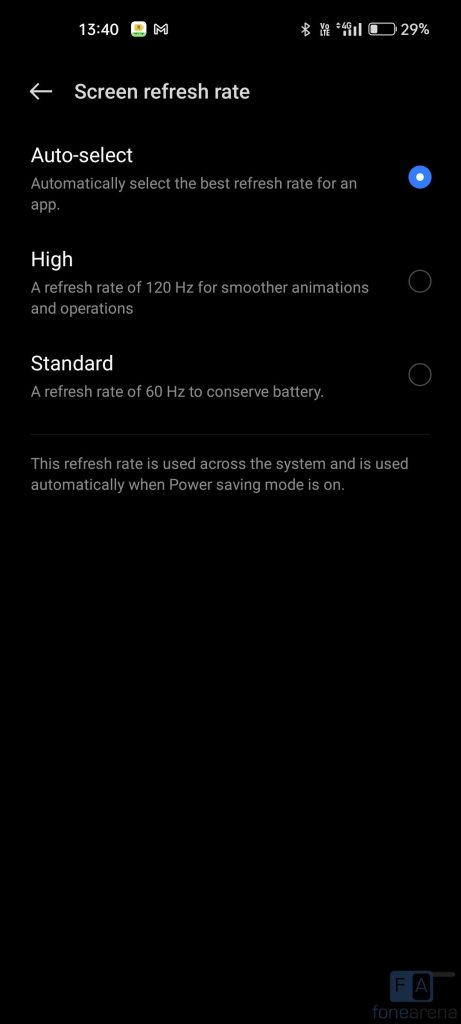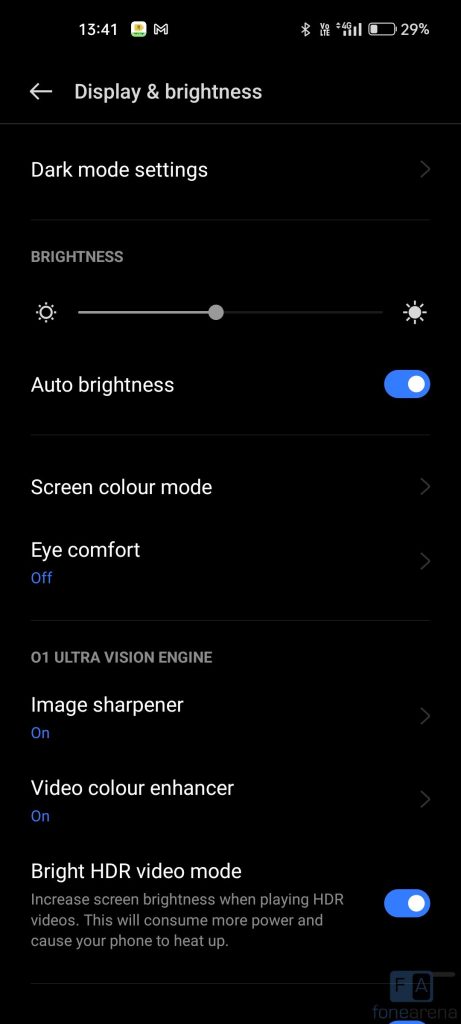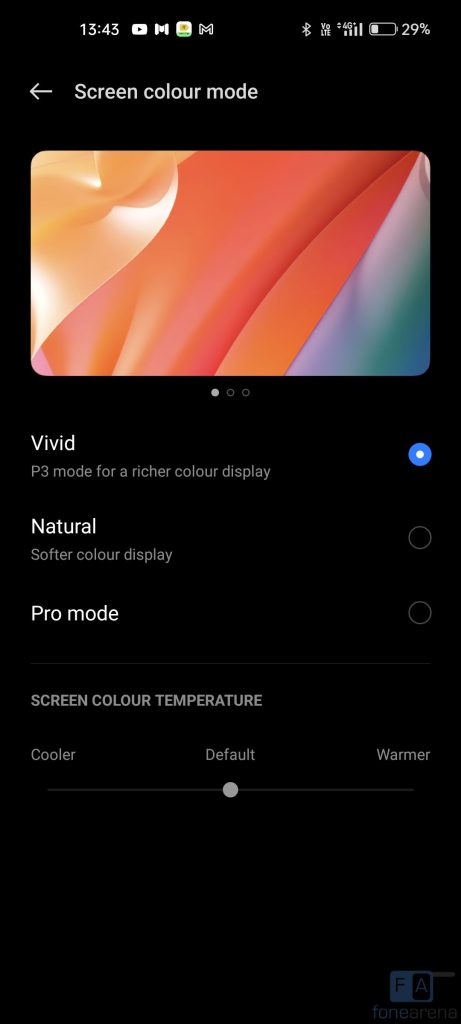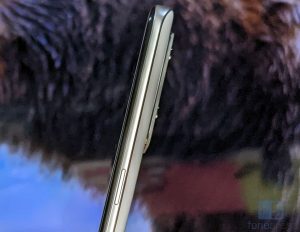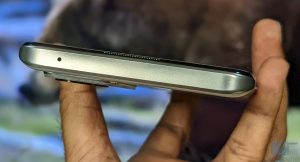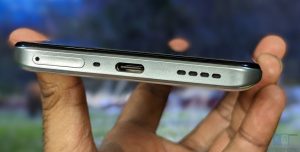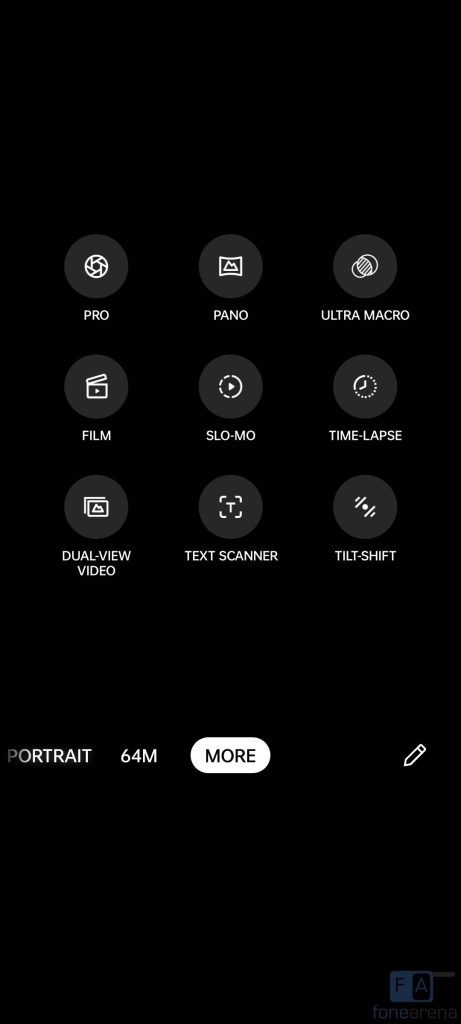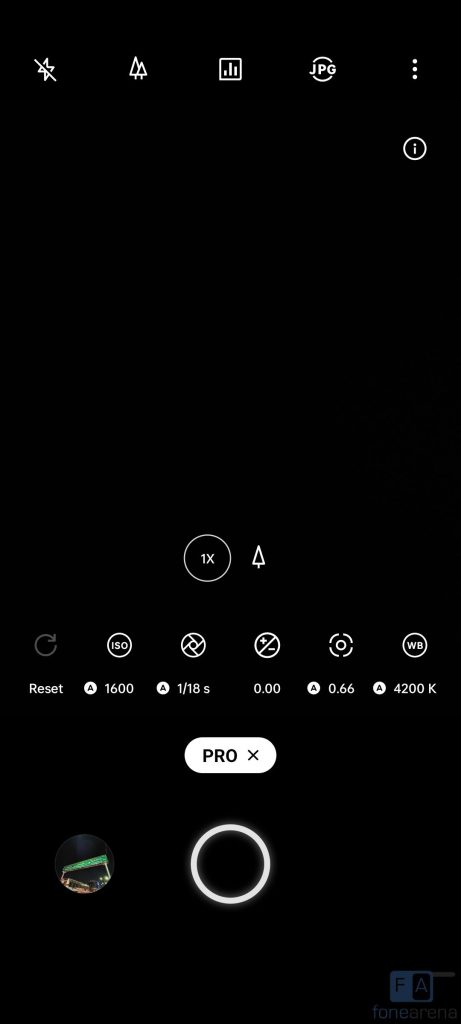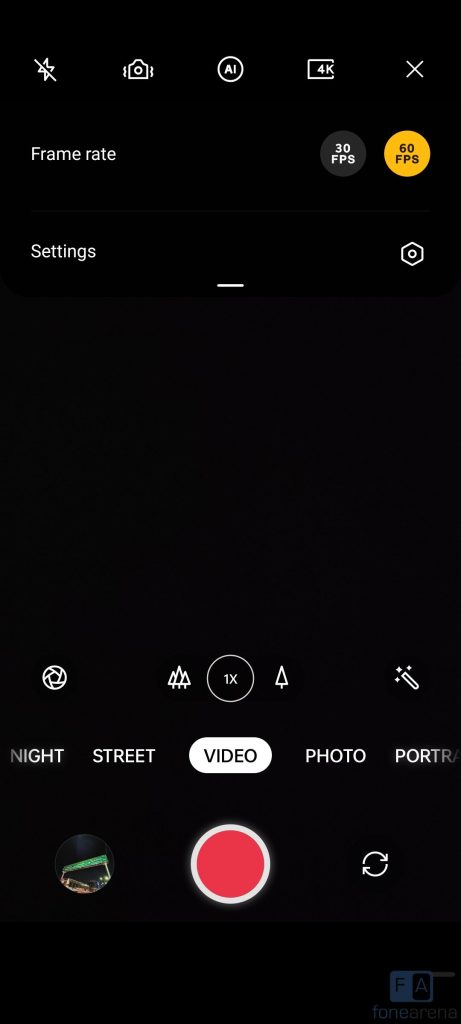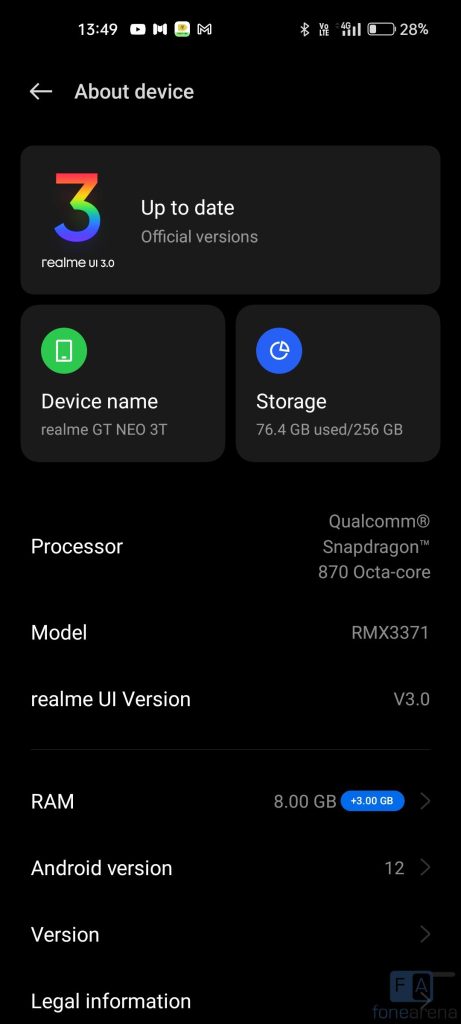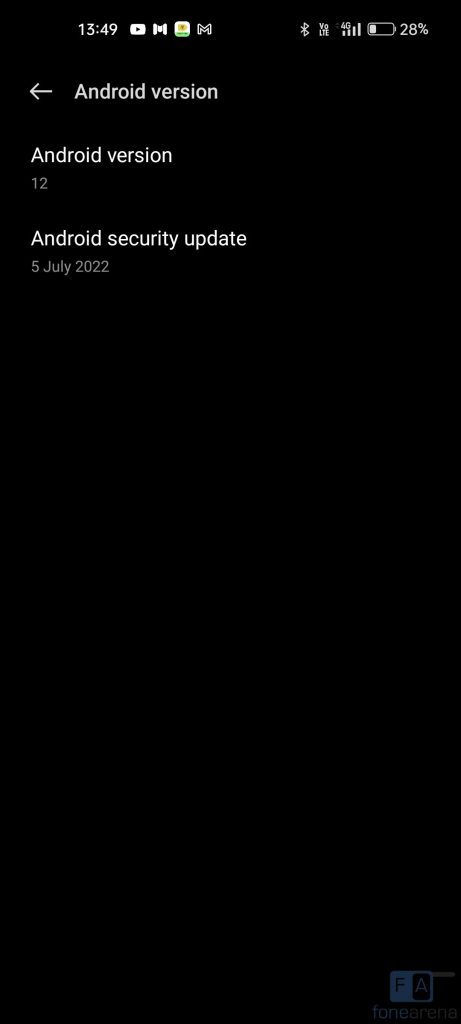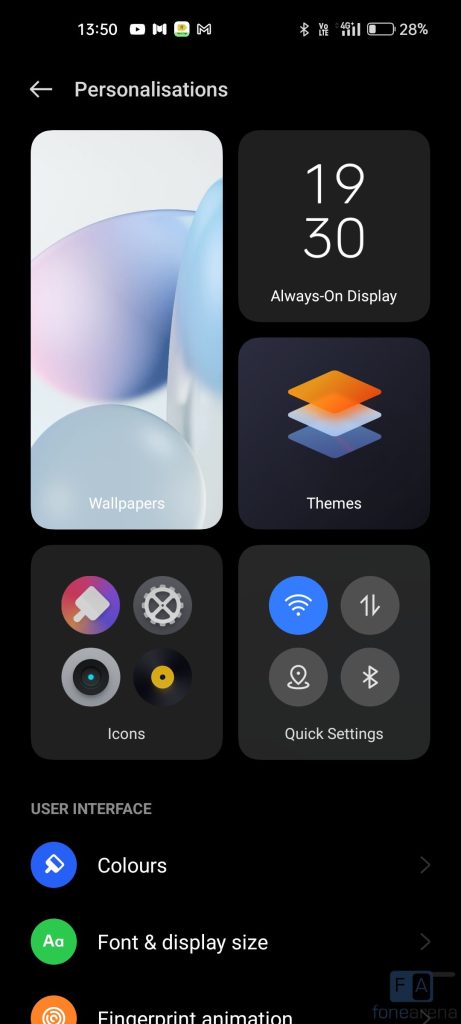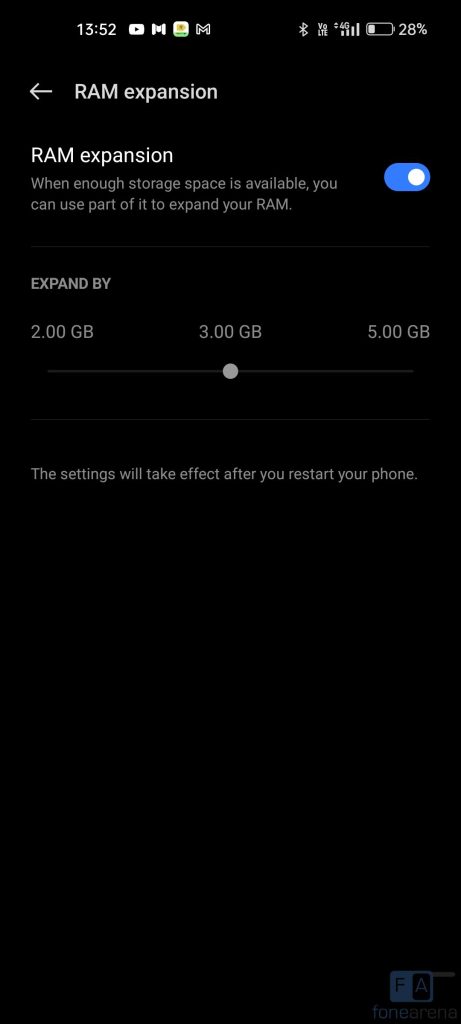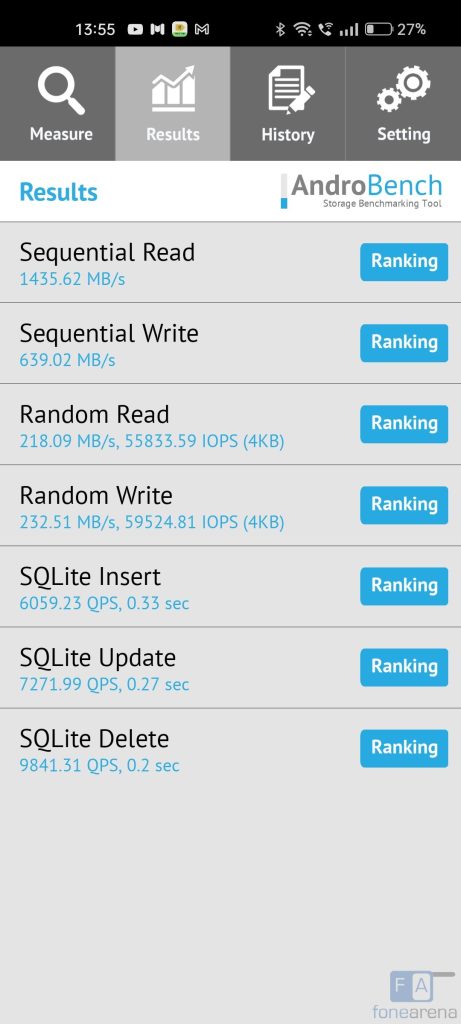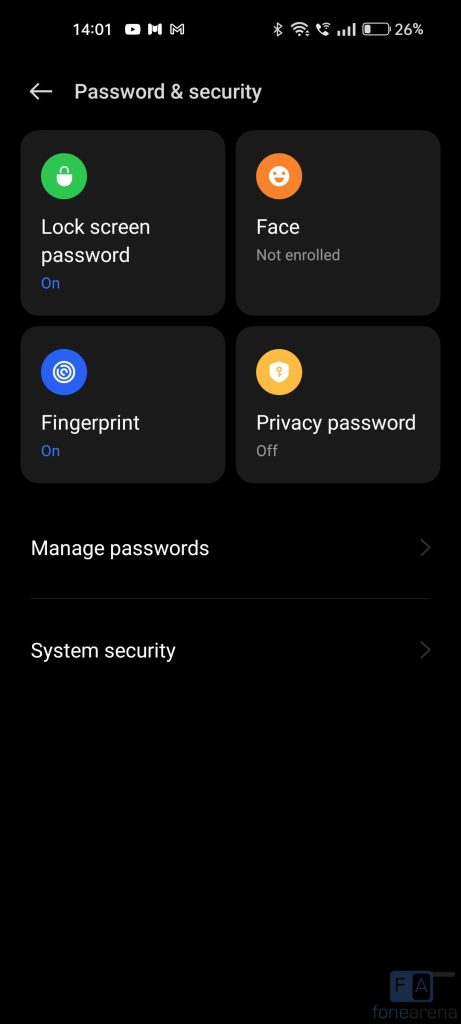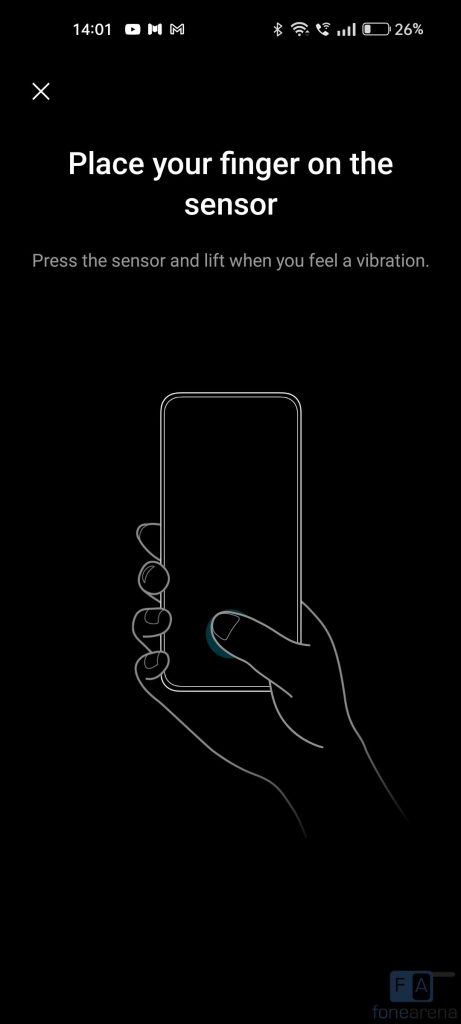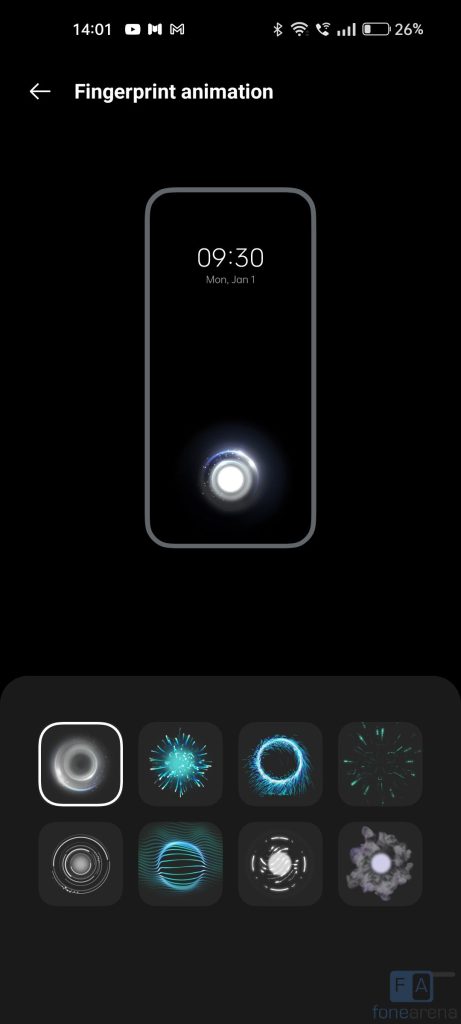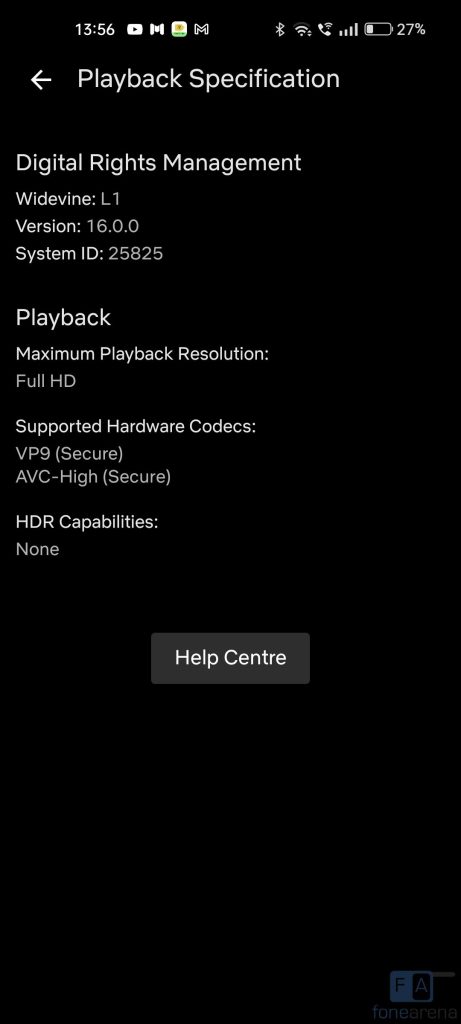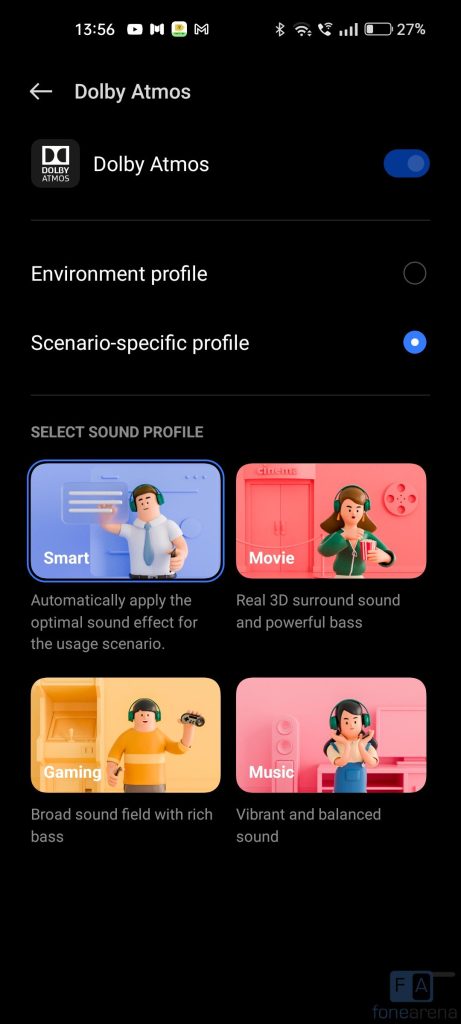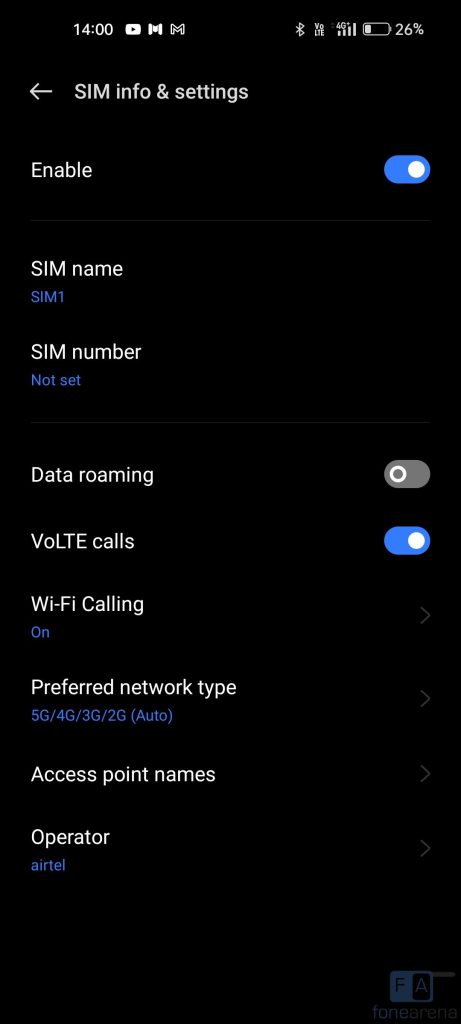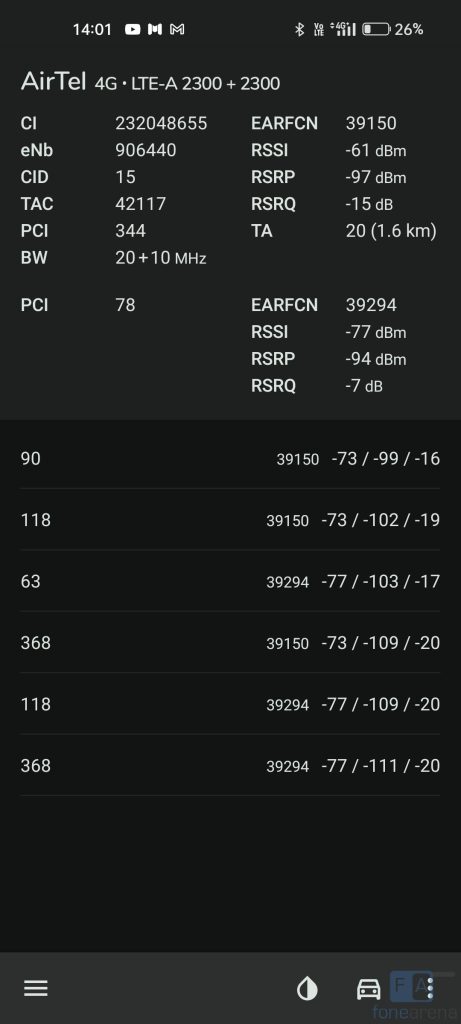
realme GT Neo 3T was launched in India last week, as the company’s latest mid-range phone. It retains almost similar specifications as last year’s GT Neo 2 including the Snapdragon 870 SoC, 120Hz AMOLED screen and the cameras. However, this upgrades the 65W charging with the 80W fast charging and has a new rear design. Let us dive into the review to find out.
| Box Contents |
| Camera |
| Battery Life |
| Conclusion |
Box Contents
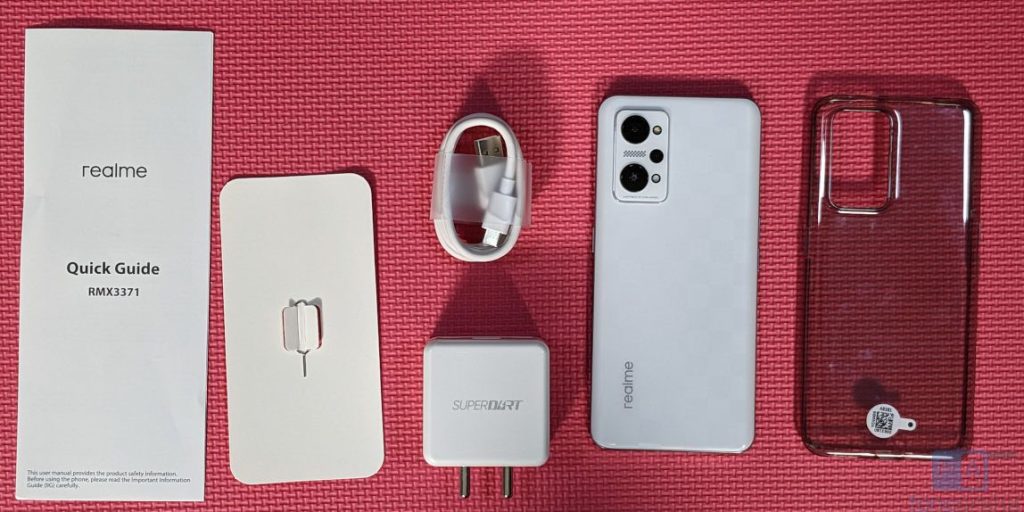
- realme GT Neo 3T 8GB + 256GB version in Neo Green color
- 2-pin 80W SuperDart fast charger (USB Type-A port)
- USB Type C Cable
- SIM Ejector tool
- Protective case
- User Guide and Warranty information
Display, Hardware and Design
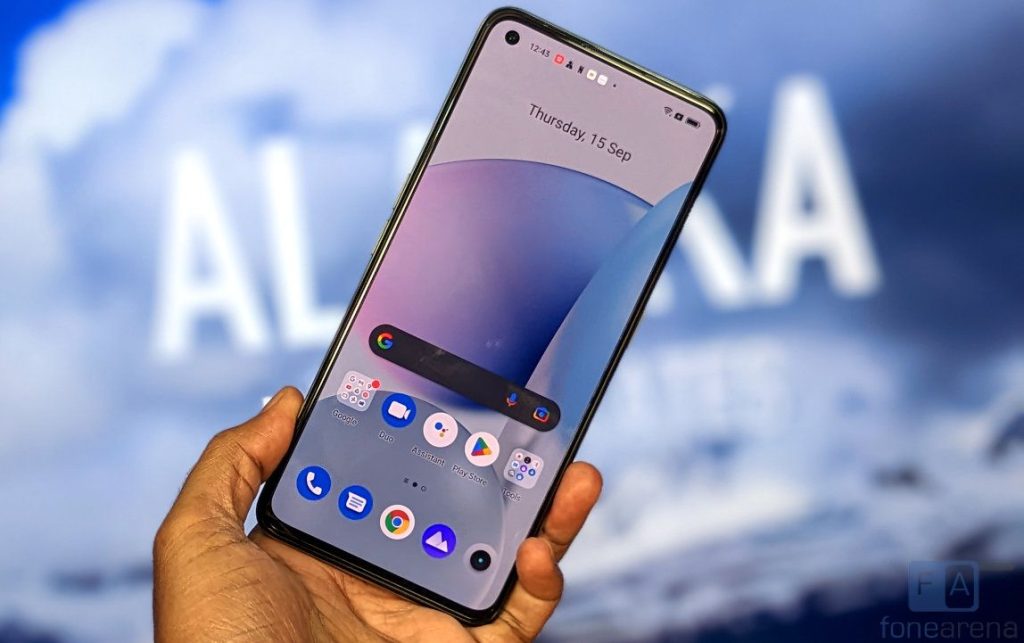
The realme GT Neo 3T sports a 6.62-inch (1080 x 2400 pixels) Full HD+ 20:9 aspect ratio E4 AMOLED display with 120Hz refresh rate, 600Hz touch sampling rate and 397 PPI. The display is bright since it has up to 1300 nits brightness with 10240 level of brightness adjustment, offers good colour output since it has 106% NTSC and 100% DCI-P3 wide Colour Gamut and the sunlight legibility is good as well. You can select from vivid, natural and pro screen colour modes.
It also has Image sharpner and video color enhancer, but there is no DC dimming. However, I didn’t face any issues with the display refresh rate in low brightness. The 120Hz refresh rate and 600Hz touch sampling rate offers a buttery smooth user experience, especially when you are scrolling through the UI and when gaming. It can only automatically switch between 30Hz, 60Hz, 90Hz and 120Hz depending on the content if you set it to auto select, thus saving the battery life. You can also force it to 60Hz or 120Hz.
It also has HDR 10 support, which works for YouTube, but it doesn’t work with Netflix. The bright HDR video mode increases the brightness when playing HDR videos, but it drains the battery. The phone has Corning Gorilla Glass 5 protection on the front.
The phone doesn’t have a notification LED, but this has an always-on-display that shows contextual info and notifications all day or as per schedule, and there is also edge light lighting that glows when you receive notifications. It doesn’t consume a lot of power since this is an AMOLED screen, but the company says that it increases the power consumption.
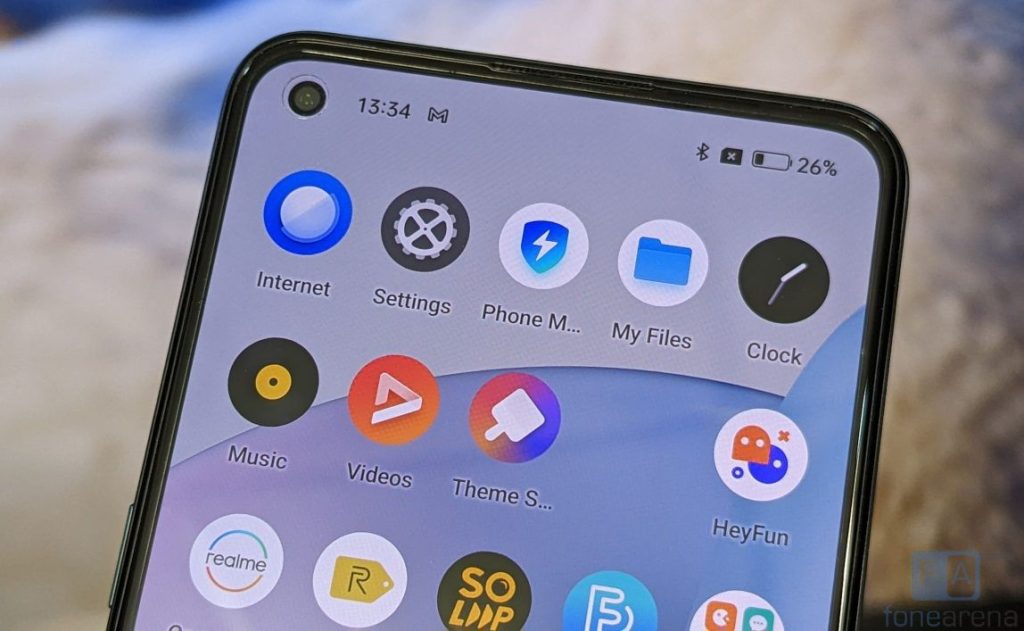
The phone has a tiny punch-hole on the left that houses a 16-megapixel camera. Above the display, there is an earpiece on the top edge that doubles up as a secondary speaker. The phone also has the usual set of proximity and ambient light sensors, as well as a gyroscope and a magnetic sensor, otherwise known as a magnetometer.

It has an in-display fingerprint scanner which is quick to unlock the phone immediately when you place your finger. You can also notice a small bezel below the screen. The haptic feedback is good as well, thanks to X-axis linear vibration motor and the phone also offers 4D vibration when gaming.
Coming to the button placements and ports, the power button is present on the right side, the volume rockers are present on the left, secondary microphone is on the top, dual SIM slot, primary microphone, USB Type-C port and the loudspeaker grill are present on the bottom. The phone doesn’t have an expandable storage. The phone has polycarbonate frame, but the matte finish on the sides, so it doesn’t slip out of the hands.

Coming to the design, the phone comes in three colors. The Drifting White colour that we have has a rear design inspired from racing flags in motorsports. There is no doubt, this is an attractive-looking phone. For the Dash Yellow, realme said that it has added nano fluorescent particles into the silk-screen printing ink. After over a dozen rounds of process overlay optimization, it finally achieved the bright yellow effect under the sun.
Since it has a huge battery, it weighs about 194 grams, which is decent. The phone doesn’t have IP ratings.
Camera
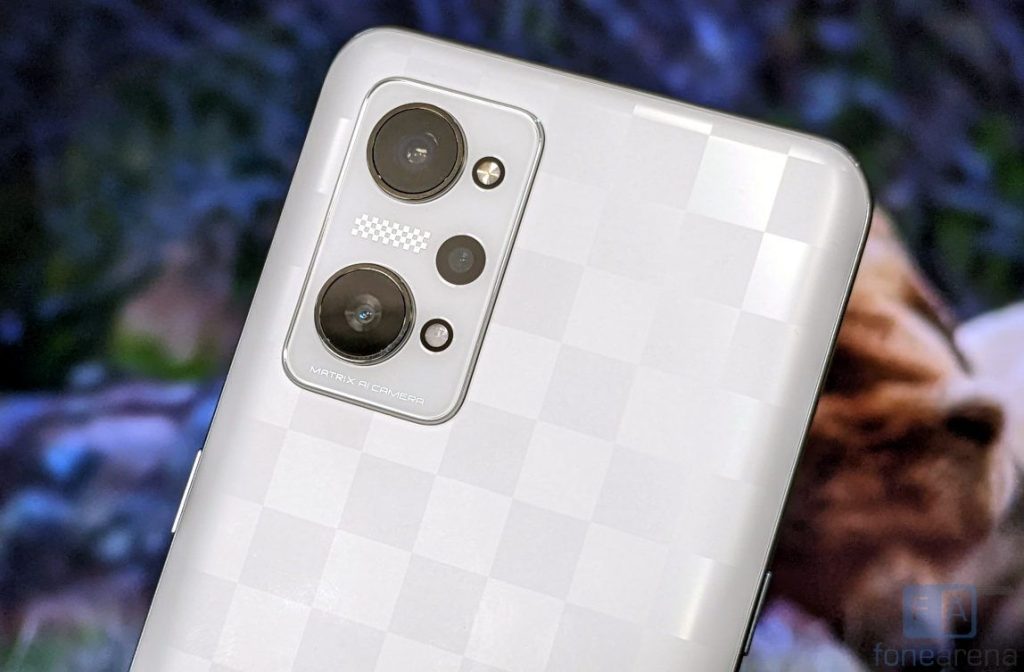
Camera setup
- 64MP primary camera with f/1.8 aperture, EIS
- 8MP 119° Ultra-wide camera with f/2.3 aperture
- 2MP 4cm macro camera with sensor, f/2.4 aperture
- 16MP front camera with f/2.5 aperture
The camera UI is same as the one realme UI 3.0 phones that has features like dual video, AI color portrait and bokeh flare portrait for images. There is also Dynamic bokeh option for photos. For video, you only get AI color portrait. There is also AI option for video and Pro video in night mode. The rear camera offers 16MP output after pixel binning, and the front camera images are 16MP in size.
Daylight shots came out well, and the dynamic range is better with auto HDR. There is AI mode which recognizes different photo scenes and automatically adjusts camera settings to make boost the colours. 2X is decent, but once you zoom after that the quality degrades since it is digital zoom. The portrait mode is decent and the 2MP macro camera is useless, so better use 2X zoom with the normal camera.
Low light shots are decent, but it could have been better. The night mode makes it better, but it still has noise. There is also a pro or pro nightscape mode, but it needs a tripod. There is also starry mode, which also needs a tripod. The front camera is also good in daylight, and there is also HDR mode, but it doesn’t have any portrait filters. The bokeh shots were decent, but the edge detection is not the best since it is just uses software.
Check out the camera samples.
It can record videos in up to 4K 60 fps, slow motion at 120fps, 720p at 240 fps and the front camera can record 1080p 30fps videos. There is also AI mode and ultra-wide video shooting, but these are limited to 1080p 30fps. It uses EIS which just a decent job, and the ultra steady mode helps a bit, but stabilization feels jittery. Wish it had OIS for a better stabilization.
Software, UI and Apps
It runs Android 12 based realme UI 3.0 out of the box. It has Android security patch for July 2022. It will get 2 Android updates and 3 years of security patches. The company has confirmed Android 13 early access update for the phone in October. relame UI 3.0 adds 3D icon, personalization on AOD, AI Smooth engine, floating window 2.0, smooth animation engine, security and privacy features, phone manager 2.0 and app permission recording.
Apart from the usual set of realme apps and Google apps, it comes with Amazon Shopping, Booking.com, Josh, Facebook, LinkedIn, Snapchat and Moj. Most apps can be uninstalled, but the Finsell Pay app can’t be uninstalled since it is a system app. However, you can use the ADB commands to remove them.
Out of 8GB LPDDR4X RAM, you get 7.5GB of usable RAM, and about 4GB of RAM is free when default apps are running in the background. It also has DRE or dynamic RAM expansion feature, which uses the built-in storage as RAM. This has up to 5GB of additional RAM expansion. Out of 256GB, you get about 225GB of free storage. The phone uses UFS 3.1 storage, and we got sequential read speeds of about 1435 MB/s.
Fingerprint sensor and Face unlock
It has an in-display fingerprint sensor that unlocks the phone quickly, but it is not as fast as a physical fingerprint sensor. You can add up to 5 fingerprints. You can also use the fingerprint for app local and payments in apps. Furthermore, you can change the fingerprint animation, but you can’t disable it. The phone also has face unlock, but it is not as secure as fingerprint, and also doesn’t work if you use sunglasses or hats.
Music and Multimedia
YouTube Music is the default Music Player that has Dolby Atmos with customizable Smart, Movie, Gaming and Music modes. It doesn’t have FM Radio support. Audio through the stereo speakers is good, but in full volume there is a slight distortion. Audio through earphones using is good. There is Dolby Atmos, but it works only when you use the headset. This has Widevine L1 so that you can play HD content on Netflix and other streaming apps. It also supports HDR content on YouTube, but this doesn’t work on Netflix. It is not clear if this will be available with an update in the future.
Dual SIM and Connectivity
The GT Neo 3T has support for 5G SA with support for SA (n41/n78/n1/n3/n5/n8/n28A) / NSA (n41/n77/n78) Network Bands in India. It has 4G Wi-Fi and VoLTE with support for Carrier Aggregation on 4G. Other connectivity options include Wi-Fi 6 802.11 ax (2.4GHz + 5GHz) 2X2 MIMO, VoWiFi / Wi-Fi calling support, Bluetooth 5.2, GPS (L1 + L5)/ GLONASS / Navic/ QZSS/ Galileo. It also has NFC support. Moving on, the call quality is good, and we did not face any call drops and the earpiece volume was loud.
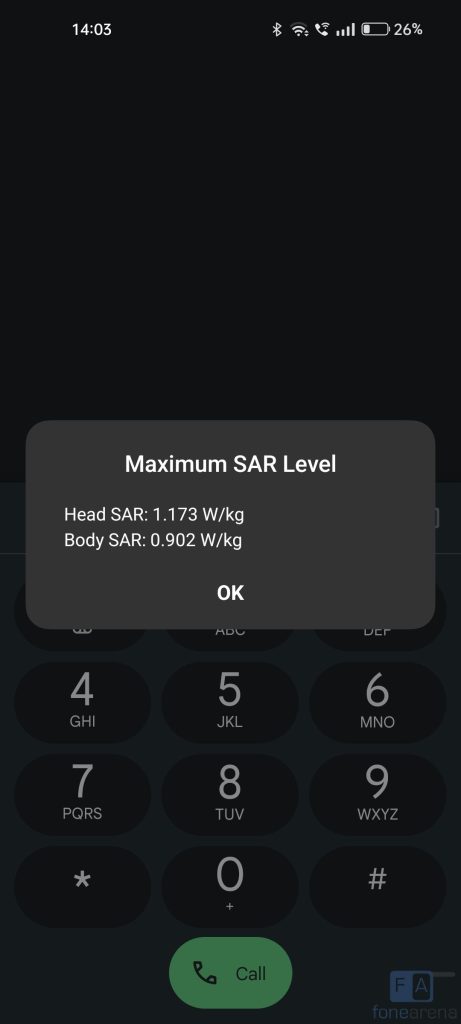
The GT Neo 3T’s body SAR is 0.902W/Kg and head SAR is at 1.173/Kg which is slightly high compared to some mid-range phones, but it well under the limit in India which is 1.6 W/kg (over 1 g).
Performance and Benchmarks
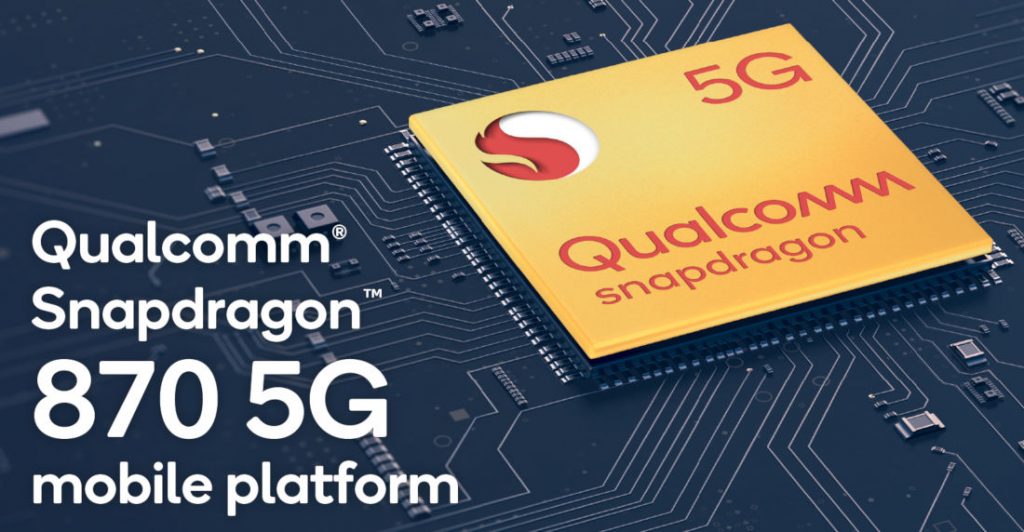
This is powered by the reliable Snapdragon 870 6nm Mobile Platform that uses Qualcomm Kryo 585 CPUs. It has 1 x Kryo 585 Prime CPU (A77-based) at up to 3.2GHz, 3 x Kryo 585 Performance CPUs (A77-based) at up to 2.42GHz, 4x Kryo 585 Efficiency CPUs (A55-based) at up to 1.80GHz
The Adreno 650 GPU offers a smooth gaming performance even in graphic intensive games, and the phone doesn’t get too hot even during long hours of gaming, thanks to 3D stainless-steel VC cooling chamber that has an area of up to 4129mm², which is the largest on a realme phone. It also has aerospace-grade diamond heat dissipation gel. The super large heat sink area can cover most parts of processor and battery area that significantly reduces the core temperature by up to 18° C and keep the phone in a high-performance state.
The phone gets a bit warm on intensive gaming or when recording 4K videos for long, but it doesn’t too hot. We did not face any issues or frame drops in the graphic-intensive games like COD, BGMI and Genshin Impact. It reached maximum 42º in our testing indoors in Wi-Fi, but this might vary outdoors in 4G. That said, check out some synthetic benchmark scores below.
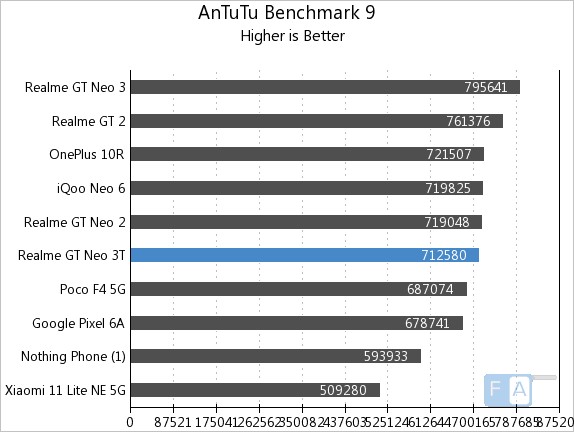
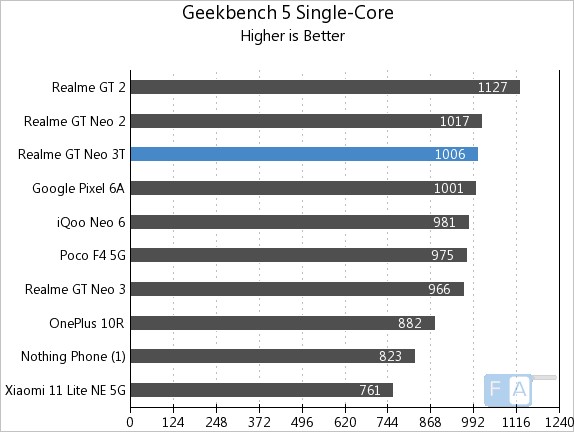
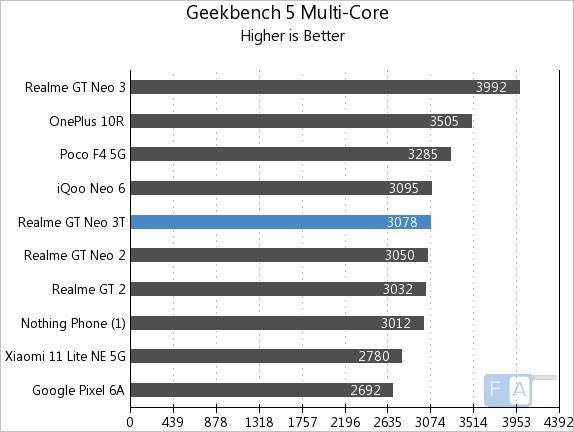
As you can see in the benchmarks, the realme GT Neo 3T powered by the Snapdragon 870 is on par with other 870-powered phones, but the Dimensity 8100 and 888-powered phones are on the top.
Battery life

Coming to the battery life, the phone packs a 5000mAh (typical) battery. It can easily last for more than a day with heavy use with 4G enabled and multimedia use, and will last easily for 2 days with minimal use. I got about 2 hours of screen on time with 2 days of use mostly on Wi-Fi. Since the phone has support for Super Dart 80W fast charging, it can charge from 0 to 50% in 12 minutes and up to 100% in about 31 minutes with the bundled 80W charger. However, it doesn’t show 80W animation when charging, and just shows SuperDart.
Conclusion
At a starting price of Rs. 29,999, the realme GT Neo 3T is a reliable mid-range smartphone from realme which doesn’t see a lot of changes compared to the realme GT Neo 2. Wish the company had added OIS for the camera.
Pricing and availability
The realme GT Neo 3T is priced at Rs. 29,999 for the 6GB + 128GB model, Rs. 31,999 for the 8GB + 128GB model and the 8GB + 256GB model costs Rs. 33,999. It will be available from Flipkart, realme.com, and offline stores starting from September 23rd.
With the launch day offer, the phone is available for as low as Rs. 22,999, which is Rs. 7000 discount on the original price that includes discounts and bank offers. There is also extra Rs. 3000 discount on exchange.
Alternatives
The POCO F4 and iQOO Neo6 with the same 870 chip are good competion for the GT Neo 3T with the ongoing festive offers. Both these have OIS, which the realme phone lacks, and the POCO F4 also comes with Dolby Vision support.
Pros
- 120Hz E4 AMOLED HDR display is brilliant
- Smooth performance and good gaming performance
- Stereo speakers, Dolby Atmos
- Good battery life with 80W fast charging
- Good build and attractive rear design
Cons
- Same old camera setup, no OIS
- A lot of preloaded apps

